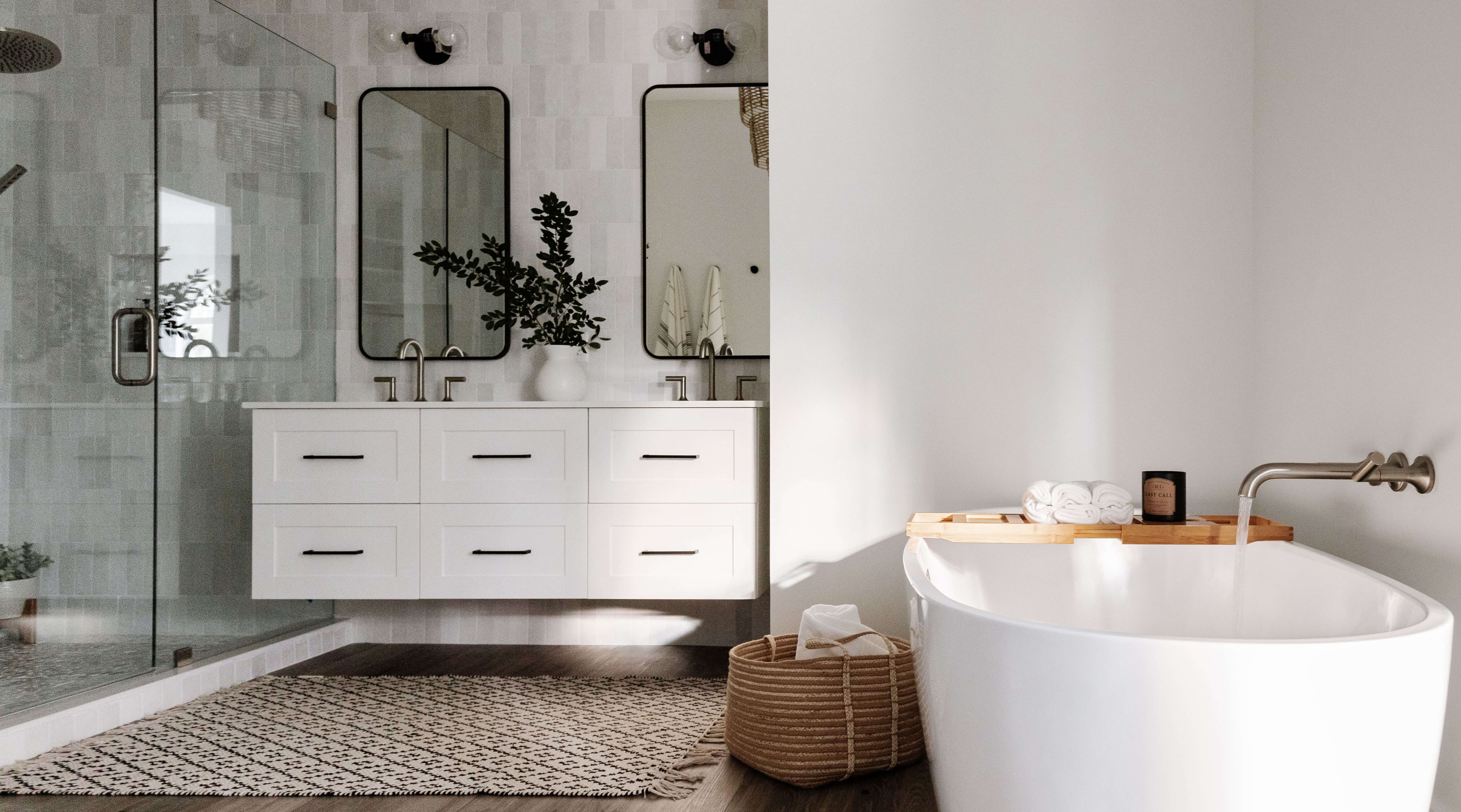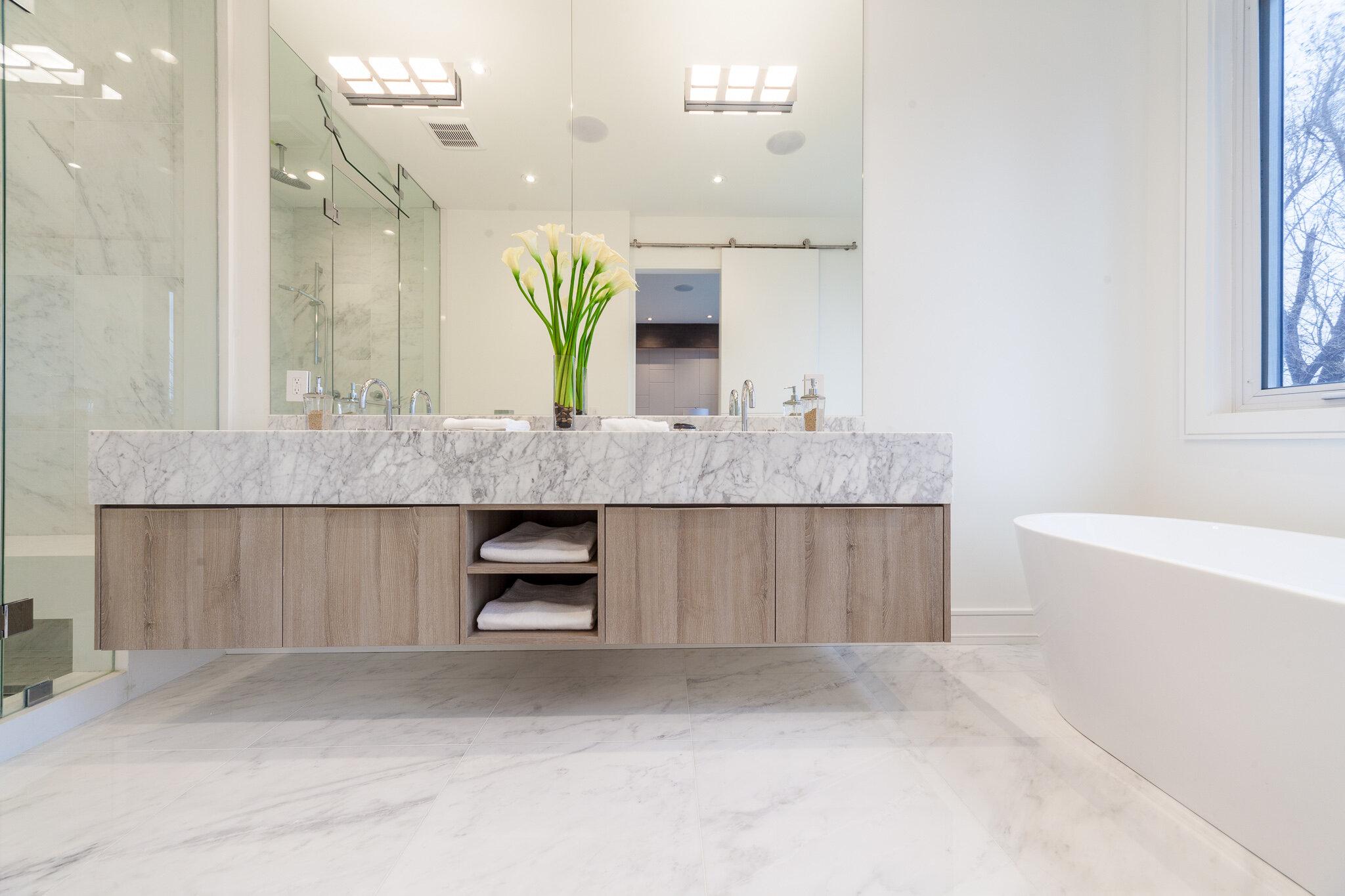Exploring 48″ Bathroom Vanity Options: 48 Modern Bathroom Vanity

A 48″ bathroom vanity is a popular choice for many homeowners, offering ample storage space and a stylish focal point for the bathroom. With a variety of styles available, finding the perfect 48″ bathroom vanity to complement your bathroom’s aesthetic and functionality can be an exciting journey. Let’s delve into the different styles and explore their unique characteristics.
Modern Bathroom Vanities, 48 modern bathroom vanity
Modern bathroom vanities are characterized by clean lines, minimalist designs, and a focus on functionality. They often feature sleek, geometric shapes, bold colors, and high-quality materials like stainless steel, glass, and natural stone. Modern vanities prioritize simplicity and efficiency, emphasizing open storage solutions and integrated lighting. A popular example is a vanity with a floating countertop, a sleek cabinet with integrated drawers, and a large mirror with integrated LED lighting. These vanities create a sense of spaciousness and sophistication, perfect for contemporary bathrooms.
Contemporary Bathroom Vanities
Contemporary bathroom vanities share similarities with modern vanities but often incorporate more organic shapes and textures. They may feature curved edges, unique hardware, and a blend of natural and industrial materials like wood, metal, and concrete. Contemporary vanities often prioritize a sense of warmth and comfort, incorporating elements like wood grain or textured surfaces. A good example is a vanity with a solid wood countertop, a combination of open shelving and drawers, and a unique, geometrically shaped mirror. These vanities offer a more eclectic and personalized look, suitable for bathrooms with a modern yet inviting feel.
Transitional Bathroom Vanities
Transitional bathroom vanities bridge the gap between traditional and modern styles. They feature a blend of classic design elements with modern touches, creating a balanced and timeless aesthetic. Transitional vanities often incorporate traditional features like ornate hardware and carved details, but with a more streamlined and simplified approach. They typically feature a combination of wood and metal, with a focus on natural materials and warm colors. A classic example is a vanity with a traditional cabinet design, a solid wood countertop, and brushed nickel hardware. These vanities offer a sense of elegance and sophistication, suitable for bathrooms that aim for a classic yet contemporary look.
Farmhouse Bathroom Vanities
Farmhouse bathroom vanities are characterized by a rustic and cozy aesthetic, often incorporating natural materials and distressed finishes. They typically feature solid wood construction, open shelving, and a focus on functionality. Farmhouse vanities often have a weathered or distressed look, with details like exposed wood grain and rustic hardware. A popular example is a vanity with a reclaimed wood countertop, open shelving, and distressed metal hardware. These vanities create a warm and inviting atmosphere, perfect for bathrooms with a rustic or farmhouse style.
Table of 48″ Bathroom Vanity Styles
| Style | Features | Materials | Price Range |
|---|---|---|---|
| Modern | Clean lines, minimalist design, sleek shapes, bold colors, integrated lighting | Stainless steel, glass, natural stone | $1,000 – $5,000+ |
| Contemporary | Organic shapes, unique hardware, blend of natural and industrial materials | Wood, metal, concrete | $1,200 – $6,000+ |
| Transitional | Classic design elements with modern touches, ornate hardware, streamlined approach | Wood, metal, natural materials | $1,500 – $7,000+ |
| Farmhouse | Rustic aesthetic, natural materials, distressed finishes, open shelving | Solid wood, reclaimed wood, distressed metal | $1,000 – $4,000+ |
Choosing the Right 48″ Bathroom Vanity for Your Needs

Selecting a 48″ bathroom vanity is a significant decision, as it sets the tone for the entire space. Your choice should reflect your unique style, functionality needs, and the overall bathroom design. This guide provides a comprehensive approach to selecting the perfect vanity for your bathroom, guiding you through the process of choosing the right style, materials, and features to enhance your bathroom’s aesthetic and practicality.
Space Constraints and Storage Requirements
The first step is to assess your bathroom’s space and storage needs. A 48″ vanity offers ample space, but you need to ensure it fits comfortably within the designated area. Measure the available width, depth, and height to determine the vanity’s ideal dimensions. Consider the location of other fixtures, such as the toilet and shower, to ensure adequate movement space.
- Measure your bathroom space accurately: Before purchasing, carefully measure the available width, depth, and height of the area where the vanity will be placed. Account for any obstacles, such as pipes or walls, that may restrict the placement of the vanity.
- Determine your storage needs: Assess the amount of storage you require. Consider the number of drawers, shelves, and cabinets needed to accommodate your toiletries, towels, and other bathroom essentials.
- Evaluate the vanity’s depth: Ensure the vanity’s depth provides sufficient counter space for your bathroom necessities, such as a sink, mirror, and other decorative items.
Matching the Vanity Style to the Bathroom Design
Matching the vanity style to your bathroom’s overall design is crucial for creating a cohesive and visually appealing space. Consider the existing décor, color scheme, and architectural elements of your bathroom.
- Traditional Style: Traditional vanities often feature intricate carvings, ornate hardware, and rich wood finishes. These vanities complement classic bathroom designs with clawfoot tubs, subway tile, and vintage fixtures.
- Modern Style: Modern vanities prioritize clean lines, minimalist design, and sleek materials like metal and glass. They work well with contemporary bathrooms featuring geometric shapes, bold colors, and sleek fixtures.
- Transitional Style: Transitional vanities bridge the gap between traditional and modern styles, offering a balanced aesthetic with subtle details and clean lines. They are versatile and can complement various bathroom designs.
Choosing the Right Materials
The material of your vanity significantly impacts its durability, aesthetics, and price. Consider the following options:
- Wood: Wood vanities offer timeless elegance and natural beauty. They are durable, resistant to scratches and dents, and can be stained or painted to match your bathroom’s décor. Popular wood choices include oak, maple, cherry, and walnut.
- Laminate: Laminate vanities are a cost-effective alternative to wood. They offer a wide range of colors and finishes, mimicking the appearance of natural materials. However, laminate is less durable than wood and may be prone to scratches.
- Stone: Stone vanities, such as granite or marble, provide a luxurious and sophisticated look. They are highly durable and resistant to moisture and heat. However, stone vanities are expensive and require regular sealing to prevent staining.
Vanity Checklist
Before making your final decision, use this checklist to evaluate different vanity options:
- Countertop Material: Consider the material, color, and finish of the countertop. Options include granite, marble, quartz, laminate, and ceramic.
- Sink Type: Choose a sink that complements the vanity’s style and your bathroom’s design. Popular options include undermount sinks, vessel sinks, and drop-in sinks.
- Hardware: Select hardware, such as knobs, pulls, and hinges, that matches the vanity’s style and your bathroom’s overall design.
- Lighting: Ensure adequate lighting for the vanity area. Consider using a combination of overhead and task lighting to illuminate the sink and mirror.
Installation and Maintenance of a 48″ Bathroom Vanity
Installing a 48″ bathroom vanity is a significant undertaking that requires careful planning and execution. It involves a combination of plumbing, electrical, and carpentry skills. The process requires a keen eye for detail and a commitment to achieving a secure and aesthetically pleasing outcome. By following these steps and employing the recommended practices, you can successfully install and maintain your 48″ bathroom vanity for years to come.
Plumbing Connections
Proper plumbing connections are paramount for the functionality and longevity of your bathroom vanity. Ensure that the water supply lines are properly sized and compatible with your vanity’s fixtures. Use high-quality fittings and sealants to prevent leaks and ensure a secure connection. When connecting the drain line, make sure it’s properly vented to prevent clogs and odors.
Electrical Connections
The electrical connections for your bathroom vanity must be handled with extreme care. Consult an electrician to ensure that the wiring is up to code and that you have the appropriate outlets for your vanity’s lighting and other features. Use grounded outlets and wire the connections with care, as water and electricity can be a dangerous combination.
Securing the Vanity
Once the plumbing and electrical connections are complete, it’s time to secure the vanity to the wall. Use appropriate mounting hardware and ensure that the vanity is level. Properly securing the vanity prevents it from shifting or tilting over time, ensuring stability and safety.
Leveling the Vanity
Leveling the vanity is essential for both aesthetics and functionality. A level vanity ensures that the countertop and sink are properly aligned, preventing water from pooling or spilling. Use a level to ensure that the vanity is perfectly horizontal and adjust the feet or shims as needed.
Maintenance Practices
Maintaining your 48″ bathroom vanity is crucial for preserving its beauty and functionality. Regular cleaning and proper care can prevent damage and extend the life of your vanity. Use a mild cleaner and a soft cloth to clean the vanity’s surface and avoid harsh chemicals or abrasive cleaners that can scratch or damage the finish.
Cleaning Procedures
Cleaning your bathroom vanity should be a regular part of your cleaning routine. Wipe down the countertop, sink, and surrounding areas after each use to prevent dirt and grime from accumulating. Use a mild cleaner and a soft cloth to clean the vanity’s surface. Avoid using harsh chemicals or abrasive cleaners that can scratch or damage the finish.
Recommended Products
Use a mild soap and water solution to clean the vanity’s surface. For tougher stains, you can use a mild all-purpose cleaner. Avoid using harsh chemicals or abrasive cleaners that can scratch or damage the finish. For cleaning the sink, use a non-abrasive cleaner designed for porcelain or other sink materials.
Troubleshooting Common Issues
Common issues with a 48″ bathroom vanity include leaks, faulty hardware, and damage to the finish. To troubleshoot leaks, check the plumbing connections for loose fittings or cracks. For faulty hardware, replace the damaged parts with new ones. To repair damage to the finish, consult a professional or use a touch-up pen designed for the specific finish.
Leaks
Leaks can occur at the faucet, drain, or plumbing connections. Check the faucet for loose or worn-out washers, and replace them as needed. Check the drain for clogs or blockages, and clear them if necessary. Inspect the plumbing connections for loose fittings or cracks, and tighten or repair them as needed.
Faulty Hardware
Faulty hardware can cause a variety of issues, such as loose drawers, doors, or cabinet shelves. Inspect the hardware for signs of wear and tear, and replace any damaged or worn-out parts. Ensure that all screws and bolts are securely tightened.
Damage to the Finish
Damage to the finish can occur from scratches, chips, or stains. For minor scratches or chips, use a touch-up pen designed for the specific finish. For more significant damage, consult a professional for repair or refinishing.
